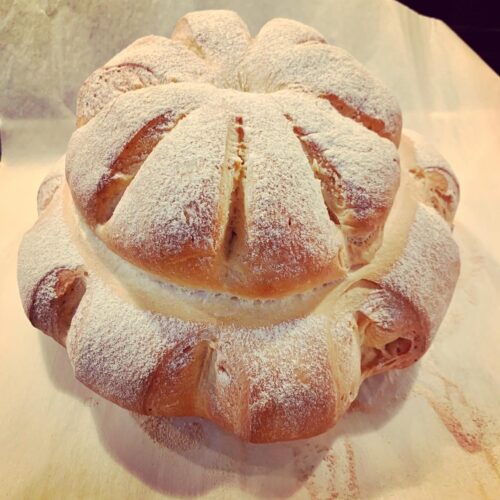
Classic English Cottage Loaf
A delicious versatile, crusty bread that is delicious with soups, sandwiches and on its own. Short hands-on time and relatively easy to make. A wonderful addition to your baking repertoire! Paul Hollywood's Recipe.
Equipment
- Baking pan lined with parchment paper
- Sharp knife for scoring dough
Ingredients
- 4 cups (500 g) bread flour (or high protein flour) plus more for dusting
- 2¼ tsp (7g) fast-action dried yeast
- 1¼ tsp (7g) fine salt
- 3½ Tbs (50g) of unsalted butter, shortening or lard, softened, cut into small pieces
- 1¼ - 1½ cups (300-450ml) lukewarm water
- Olive oil to grease bowl
Instructions
- If using a stand mixer, pour flour, yeast and salt into a mixer bowl. Add the butter (or lard, shortening) and pour in about 1 cup (225–250ml) of water. Stir, then add a further ¼-½ cup (75–100ml of water) a little at a time, until all the flour is incorporated and the dough is soft but not soggy. Mix on low-medium for 5-6 minutes, until it is smooth and silky.
- If kneading by hand, pour flour into a large bowl, add the yeast to one side and salt to the other. Add the softened butter and pour in about 1 cup (225–250ml) of water. Mix using one hand, then add a further ¼-½ cup (75–100ml of water) a little at a time, until all the flour is incorporated and the dough is soft but not soggy. Tip the dough onto a lightly floured work surface and knead for 5–10 minutes, until it is smooth and silky.
- Next, place the dough in a lightly oiled bowl, cover and leave to rise for about 1 hour, or until it has doubled in size.
- When ready, tip the dough onto a lightly floured work surface. Fold dough inwards repeatedly to knock out the air and ensure that it rises upwards, rather than outwards.
- Tear off one third of the dough and set aside. Take the larger piece and shape into a ball. Flatten the dough into a rough rectangle, then roll it out. Fold the top down and the bottom up until you have a thick belt. Then fold the two ends to the centre and press them down and you will have a chunky block. Turn the dough over. Cup both hands around the dough and move the dough around the work surface in a circular motion for a few times. This will tuck the dough under itself and create a taut surface. Repeat until the surface is smooth and taut.
- Place the shaped large ball of dough on the prepared lined pan. Repeat the rolling and shaping for the smaller piece of dough. When done, place the smaller ball on top of the larger ball, like a dough snowman.
- To join the 2 balls, dust your index and middle fingers with flour. Push them through the centre of the loaf all the way to the bottom, until you touch the pan. Do this twice to make sure the top and bottom balls are firmly joined together.Next, use a sharp knife to cut 8 slashes on both the top and lower part of the loaf.
- Then, carefully cover with plastic cling wrap (or large plastic proof bag) and let it rest for about an hour. Preheat oven to 415°F (230°C) and put an oven proof tray (I used my handy Le Creuset cast iron pan) at the bottom of oven.
- When ready, remove wrap and lightly dust with flour. Place the pan into the oven. Fill the prepared heated tray with water to create steam and quickly shut the oven door. Bake for 15 minutes, then lower the oven to 375°F (190°C) and bake for another 20 minutes, or until the surface is golden brown. Gently tap the bottom of bread - it should sound hollow. If not, let it bake for another 3-5 minutes.
- Remove from oven and transfer to cooling rack. Your cottage loaf is ready!
Notes
fabfoodflavors.com/how-to-make-a-classic-english-cottage-loaf